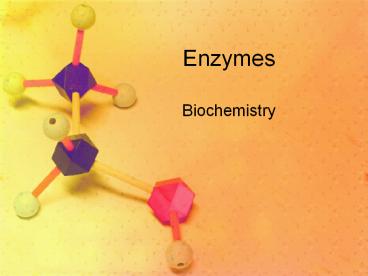Enzymes - PowerPoint PPT Presentation
1 / 18
Title:
Enzymes
Description:
Enzymes Biochemistry What You Need to Know! Enzymes work by lowering the energy of activation. The catalytic cycle of an enzyme that results in the production of a ... – PowerPoint PPT presentation
Number of Views:401
Avg rating:3.0/5.0
Title: Enzymes
1
Enzymes
- Biochemistry
2
What You Need to Know!
- Enzymes work by lowering the energy of
activation. - The catalytic cycle of an enzyme that results in
the production of a final product. - The factors that influence the efficiency of
enzymes.
3
Special Proteins Enzyme
- Enzymes are proteins that speed up the rate of a
chemical Rx - Making/breaking covalent bonds in cells
- Also called a biological catalyst
- Suffix -ase
- Enzyme
- Substrate(s) ? product(s)
4
- Enzymes are large 3-D proteins that have a groove
where they bind the substrate(s) ? active site
5
Enzyme
- Each enzyme
- Has a specific 3-D structure (due to the number
and order of AA) - Can interact only with one type of substrate that
fits in the active site Lock and Key model
6
Catalytic Cycle
- Enzyme finds substrate
- Substrate binds to active site enzyme-substrate
complex
7
Enzyme Rx
- Enzyme transforms the substrate into product
enzyme product complex - Enzyme releases product
- An enzyme can carry out a chemical Rx over and
over again - it is not used up in the Rx
- Substrates are used up
8
Activation Energy
- Transformation from reactants to products
requires the input of energy activation energy - Enzymes can speed up a Rx because they lower the
activation energy of the Rx
9
Enzyme Rx RatesDepend On
- Substrate concentrations
- The more substrate, the faster the rate
- Until present enzymes reach capacity
- Enzyme concentrations
- The more enzymes the faster the rate
- Until substrate concentration becomes limiting
factor - pH
- Can slow the rate due to denaturation of enzyme
10
Enzyme Rx RatesDepend On
- Temperature
- Can slow rate due to denaturation of enzyme
- Presence of inhibitors
- Can slow down or block enzymes
11
To be continued
12
Factors that affect enzyme activity
- pH
- Enzyme pepsin in stomach does not become active
until it is in an acidic pH - Temperature
- Each enzyme has an optimal temperature range
- Cofactors or coenzymes
- Bind to the enzyme to make it functional
- Ex metals such as Zn, Fe, Co, and vitamins
- Inhibitors
13
1. Competitive Inhibitor (reversible)
- Mimics substrate molecule(s) (flat toothpicks)
but cannot be metabolized - slows down Rx rate
14
2. Non-competitive/allosteric inhibitors
(reversible)
- Molecules that do not bind to active site but at
the allosteric (other) site - leading to conformation (change in shape)
- Can turn off active site
15
Enzymes
- http//www.youtube.com/watch?vPILzvT3spCQfeature
related
16
3. Non-competitive inhibitors-(irreversible)
- Toxins
- Poisons
17
Enzyme Regulation
- Chemical chaos would result if all metabolic
pathways in the body work simultaneously - Regulation through
- Transcription/translation
- Active regulation of enzymes already made
- Allosteric Regulation
- Feedback Inhibition
18
Active Regulation
- Allosteric Regulation
- Reversible non-competitive inhibitors or
activators that the body makes - binds to allosteric site
- Feedback Inhibition
- In long metaboloic pathways final products
becomes allosteric inhibitors to the first enzyme































